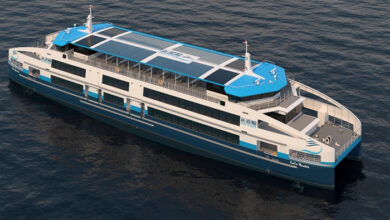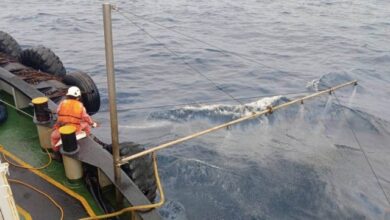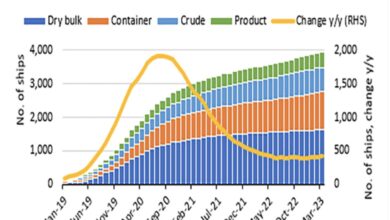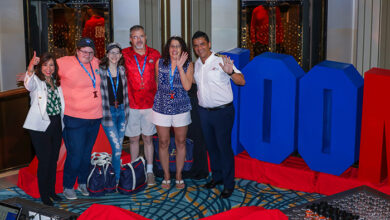
Poland : Marek Grzybowski

The role of the shipowner has evolved significantly over the past decade, with owners taking a much more active role in deciding the details of new designs. When we develop a new vessel design today, we take around 20.000 to 30.000 design candidates that are all slightly different and check how they perform in the desired operating conditions of this particular vessel. This is done in an automated process and would have never been possible without intelligent simulation software and high-performance computing clusters.

Marek Grzybowski asks 3 questions in exclusive interview for eBlueeconomy with Heikki Hansen, Team Leader, Fluid Engineering, Maritime at DNV, and Uwe Hollenbach, Principal Engineer, Fluid Engineering, Maritime at DNV

Marek Grzybowski: The merchant ship fleet currently counts over 100,000 ships. The number of fishing vessels around the world has reached 4.6 million. Until the early 2000s, around 95 percent of vessels were built to a single-point design. What are the consequences of this today?
Uwe Hollenbach: If they are still in service, many vessels built in the early 2000s would be at the end of their operational lifetime. And if they have never undergone any optimizations, then compared to the vast majority of newer ships – which have been designed to operate efficiently in a variety of conditions – these vessels are much less efficient and therefore much less competitive. Incoming regulations such as the Energy Efficiency Design Index for existing ships (EEXI) further ramp up the pressure on owners and operators to ensure that vessels meet high-efficiency standards. These IMO requirements for all vessels above 400 GT will enter into force on 1 January 2023.
You mention fishing vessels here as well. Fishing vessels are a special case and were in fact never built to a single point design because of the nature of their operations. Their design process has always included considerations for two very different scenarios: Going out to sea and returning into the harbor at high speeds and secondly, performing fishing operations at slow speeds but with the need to deliver high pull forces.
Marek Grzybowski: Container vessels were some of the first to move away from single-point designs, but by far not the only segment. How was the process of changing the shape of the ship’s hull? What was the reason for such changes? Why was the focus on optimized bow shapes?
Heikki Hansen: Being built to a single point design meant that a vessel’s hull shape, bow, and engine capacity would perform excellently at one specific speed and draft – making it perfect for its particular contract condition. This is what vessel performance was measured against in the early 2000s. Nobody guessed how much ship efficiency would be affected when vessels traveled at slower speeds and at 70 or just 50 percent cargo capacity. For container vessels, in particular, efficiency losses were devastating. Prompted by the ambition to cut costs and maximize efficiency, designers realized that with relatively small changes, you could boost ship efficiency by 5 to 10, sometimes even 20 percent, which for large deep-sea vessels equaled up to one million US dollars in savings per year.

The solution was multi-point optimization. This is an approach to ship design that no longer focuses on one operating point. Instead, a range of speeds and drafts, typically consisting of four (2×2) to nine (3×3) modes of operation, is married into the final design. In collaboration with the owner, you devised a varied operational profile in a matrix model, defining how much time the vessel was most likely to spend traveling at particular speeds and drafts. On the one hand, this meant that you would no longer have the perfect vessel for a single mode of operation. However, the designs were far more flexible and met the demands of different voyages, weather conditions, and load capacities. The optimized lines result in reduced resistance, less power demand, and greater overall efficiency.

But, of course, when these developments started, most vessels in operation had been built to a single-point design. Changing their hull shape was not an option, that would have been to expensive. What you can change is the shape of the bow. Wave resistance is very dependent on the shape of the bow and how deep it enters the water at varying speeds. Single point designs often had very voluminous bows. With an optimized, slender shape, it’s possible to generate fuel savings of 6 to 10 percent.
Advances in computer simulation technology were a key enabler for multi-point-optimization – be it for adapting the bow shape of existing vessels or for creating new designs. When we develop a new vessel design today, we take around 20.000 to 30.000 design candidates that are all slightly different and check how they perform in the desired operating conditions of this particular vessel. This is done in an automated process and would have never been possible without intelligent simulation software and high-performance computing clusters.
Marek Grzybowski: From around 2008, new ship designs no longer focused on one operating point. In what direction did the design work go? What to pay attention to in the process of designing the hull of a ship? What was the role of the shipowner ordering the ship?

Uwe Hollenbach: The first part of your question has been addressed by my colleague. The role of the shipowner has evolved significantly over the past decade, with owners taking a much more active role in deciding the details of new designs. In fact, the impulse to move away from single-point designs and look at the real operating conditions came from shipowners seeking greater efficiency gains from their newbuilds. Customizing existing new build designs to the needs of each owner is of course a more challenging process for yards. However, with efficiency gains high on the agenda for owners and regulators, doing this successfully is also a significant competitive advantage.














